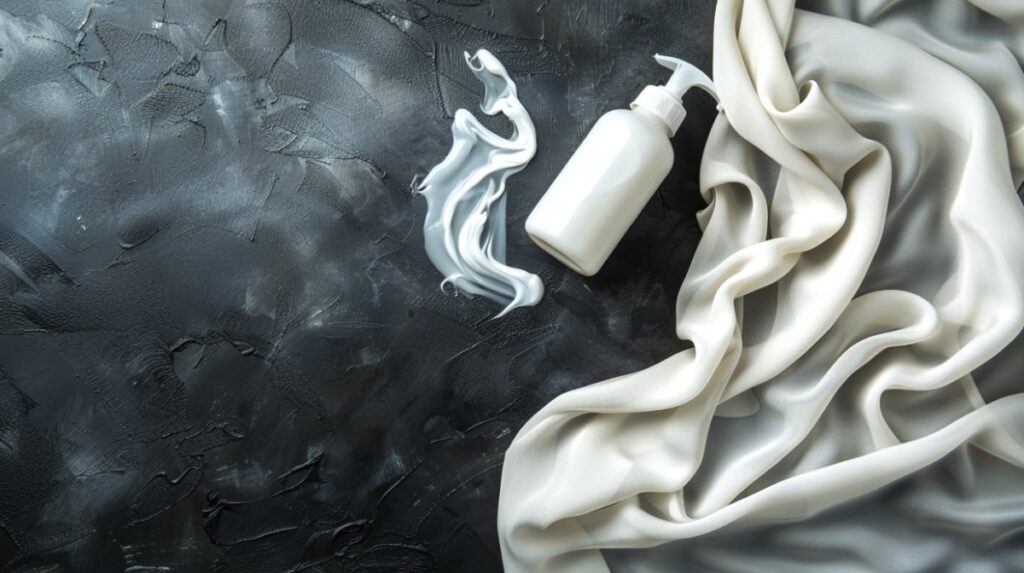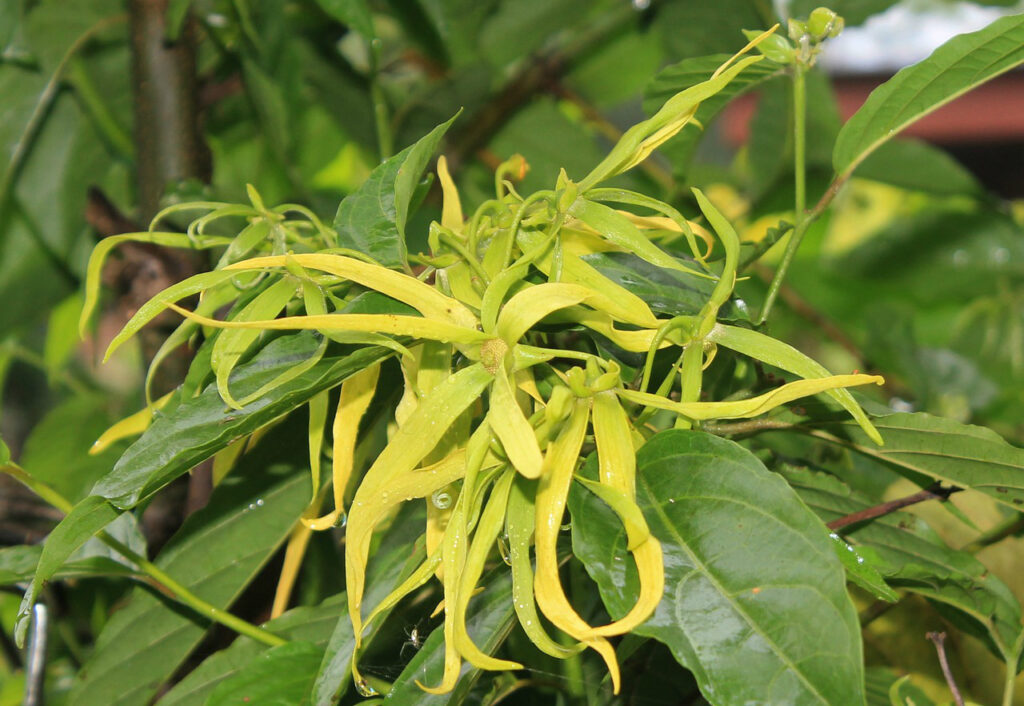Does Lotion Stain Clothes? – Easy DIYs and Prevention Hacks
It’s not the answer we’d like to give, but yes, lotion can stain clothing. Lotion stains on clothing aren’t just frustrating but quite unexpected as well.
- Types of Fabrics and Their Susceptibility to Lotion Stains
- Understanding Lotion Compositions
- Lotion and Stains: 5 Preventative Tips
- Initial Pre-Treatment Steps for Removing Fresh Lotion Stains
- Stain Removal Techniques for Different Lotion Types
- Post-Treatment: Laundering and Drying
- When to Head to the Dry Cleaner
- Lotion Stains and Fabric: Wrap-Up
- Lotion and Stains: FAQs
- How can one effectively remove lotion stains from clothing?
- Are lotion stains on black clothes more difficult to remove?
- Can calamine lotion cause permanent stains on fabric?
- What are the best methods to get lotion out of polyester garments?
- Will lotion stains on sheets wash out with regular laundering?
- Does the type of fabric affect the removal process of lotion stains?
After all, lotion is meant to keep your skin soft, not to leave marks on your fabric. The truth is that lotions contain oils and other ingredients that can leave visible stains on clothes.
However, you shouldn’t let a slip of the hand while moisturizing turn into a long-term problem for your wardrobe.
- It is possible to remove lotion stains, and understanding the right methods can save your favorite garments from being relegated to the back of the closet.
- When it comes to removing lotion stains, the key is to act fast. The longer a stain sets, the harder it becomes to get out.
- It’s easy to tackle lotion stains with simple household items and some patience.
- It’s not just about throwing your clothes in the wash; pretreatment is critical to completely remove stains during the wash cycle.
From pre-treatment with dish soap to dabbing with absorbent cloths, there are tested strategies for how to get lotion stains out of clothes that can restore them to their original condition. Actually, for just about every stain, we’d suggest pre-treatment. The sooner you can dab on soap, detergent, or a DIY solution, the better.
By following instructions tailored for lotion stain removal, you can confidently address the issue without the need for professional intervention.
Types of Fabrics and Their Susceptibility to Lotion Stains
When you encounter a lotion stain, your fabric’s material plays a significant role in how easily the stain can be removed. Different fibers react differently to both the staining agents in lotions and the products used for stain removal.
Natural vs Synthetic Fibers
Natural Fibers: Natural fibers like cotton and silk tend to absorb stains quickly due to their porous nature. Silk is a delicate fabric, so you must handle lotion stains with extra care to avoid damaging the material. Methods involving baking soda and vinegar can be useful for lifting stains from cotton and linen.
Synthetic Fibers: On the other hand, synthetic fibers, such as polyester, often have a more resilient structure against stains. However, once a stain sets in, it can be more stubborn due to the tighter weave of the fibers. It is crucial for you to act quickly with synthetic fabrics to prevent the lotion from bonding with the material.
Fabric Care Labels and Stain Resistance
Before you attempt to remove a lotion stain, always check the care label of your garment. The care label provides specific instructions that are essential for keeping your fabrics looking like new.
- It indicates whether your fabric is washable, or if it requires professional cleaning, especially for delicate items that might be prone to damage.
- Fabrics with a ‘dry clean only’ tag will need a professional’s attention, as water-based or DIY cleaning methods could lead to irreversible damage.
- For washable fabrics, the care label often contains information on the maximum temperature for washing, which is critical to prevent the stain from setting further, as well as shrinkage or damage.
So, don’t ignore your fabric’s care label!
Understanding Lotion Compositions
When you choose a lotion, its ingredients determine not just the benefits for your skin but also how it interacts with fabrics. The base of the lotion, whether oil or water, and the specific additives it contains play a crucial role in whether it might stain your clothes.
Oil-Based vs. Water-Based Lotions
Oil-Based Lotions: These lotions contain oils that can leave greasy stains on clothes. Ingredients like petroleum and various natural oils are common in these types of lotions. Because oils don’t dissolve in water, removing these stains might require more than just a typical wash cycle.
That’s especially true if repeated layers of lotion have been absorbed into your fabric over a long period of time.
Examples of common oils in these lotions include:
- Coconut oil
- Jojoba oil
- Olive oil
- Petroleum
- Mineral Oil
Water-Based Lotions: Lotions labeled as water-based are less likely to leave a stain, as they are lighter and more easily rinse out with water. As the name suggests, water is the main ingredient in this type of lotion. Thus, these lotions absorb more quickly into the skin and typically evaporate faster from fabrics.
Still, even water-based lotions use oils and emollients. Oils simply make up less of the finished product vs. traditional lotions.
Additives in Lotions That Affect Stains
Additives: In addition to the base ingredients, lotions may contain various additives that can impact how they stain. These might include dyes, fragrances, and stabilizers, which can interact differently with fabric types.
Here’s a brief overview of some additives:
- Dyes: These can leave a color stain on light-colored fabrics.
- Fragrances & Essential Oils: Higher concentrations can contribute to oil stains, especially without regular washing.
- Mineral-Based Additives: Ingredients like zinc oxide, often found in sunscreen lotions, can leave a white residue on fabrics.
By knowing the composition of your lotions and creams, you will be better equipped to choose products that are less likely to stain your clothes. Always check the label for specifics on the lotion’s base and additives to anticipate any potential interaction with fabrics.
Lotion and Stains: 5 Preventative Tips
Perhaps the simplest way to prevent lotion stains on the clothes is to avoid getting on them during application. Additionally, give your lotion a few minutes to absorb and dry before putting your clothing on.
The more lotion that absorbs into your skin and dries, the less that will absorb into your clothing. More on these tips and others below.
1.) Choose the Right Fabric: Some materials repel lotion better than others. Opt for tightly woven fabrics, which are less likely to absorb lotion compared to loosely knit textures.
2.) Allow Lotion to Absorb: Before dressing, give the lotion time to absorb into your skin. This reduces the likelihood of transfer onto your clothes. Remember: Lotion that doesn’t absorb into your skin will absorb into your clothing.
3.) Be Mindful of Application: Use lotion sparingly (or not at all) near cuffs and collars, where fabric often comes into contact with skin.
4.) Apply Lotion Evenly: Ensure you rub the lotion into your skin uniformly to avoid excess product that can smear onto clothing.
5.) Use Thin Layers: Multiple thin layers of lotion may be better than one thick layer, as they absorb more quickly and thoroughly. Only apply as much lotion as your skin needs to remain moisturized, there’s no need to overdue it!
Initial Pre-Treatment Steps for Removing Fresh Lotion Stains
When you notice a fresh lotion stain on your clothing, acting quickly can prevent it from setting. The following steps will guide you through the initial process of stain removal, making use of everyday household items.
Blotting Technique
Firstly, do not rub the stain, as it can further embed the lotion into the fabric. Instead, gently blot the affected area with a paper towel to remove as much lotion as possible.
Use a lifting motion and rotate the paper towel to a clean area frequently to avoid re-depositing the lotion back onto the fabric.
Cold Water Rinse
After blotting, immediately rinse the stained area with cold water to dilute the remaining lotion.
Hold the fabric under the tap, allowing the cold water to run through the stain from the back, which helps push the lotion out of the material rather than further in.
Applying Absorbent Materials
If the stain persists after rinsing, apply an absorbent material such as cornstarch or baking soda directly on the stain.
These substances can help absorb the oily component of the lotion. Sprinkle a generous amount over the stain, and let it sit for 10-15 minutes. You can make a thick paste with a bit of water to spread it more easily over the stain.
If using baking soda, we recommend mixing a bit of dish detergent for its oil-cutting properties. After the above-recommended time has been allotted, simply launder as usual.
Stain Removal Techniques for Different Lotion Types
Dealing with lotion stains on clothes requires a methodical approach. Different types of lotions have varied compositions, so the stain-removal process can differ. Here, we focus on the soap and water approach and the use of enzyme-based cleaners to tackle these stubborn marks.
Soap and Water Approach
To address non-oily lotion stains, a simple combination of soap and water can be quite effective. Begin by:
- Blotting the stain with a dry cloth to remove any excess lotion.
- Mixing a small amount of dishwashing liquid or laundry detergent with warm water.
- Soaking the garment in the mixture, ensuring the stained area is fully submerged.
- Gently rub the fabric together over the stained area, then Rinse thoroughly with clean water.
For lotions that contain oils or have left a greasy mark, pre-treat the stain with dishwashing liquid, which is designed to cut through grease. Apply it directly to the stain and gently work it in before rinsing.
Utilizing Enzymes and Detergents
For more persistent or complex stains, particularly from oil-based lotions, enzyme-based stain removers can be indispensable. Follow these steps:
- Apply an enzyme-based laundry detergent directly to the stain.
- Allow it to sit for 10-15 minutes, giving enzymes time to break down the oils and lotion components.
- Wash as usual with the warmest water that is safe for the fabric. If the care label allows, adding oxygen-based bleach can boost the stain-fighting power.
Remember to always check the care label and conduct a spot test before using any product on your clothing.
Enzyme cleaners are typically more effective on organic stains and may not work as well on mineral oil-based lotions. In those situations, soaking the garment in oxygen-based bleach mixed with water might yield better results.
Hot Water and Stain Remover
For treating resistant lotion stains, begin by laying the stained clothing flat and applying a stain remover directly to the affected area. Allow the solution to penetrate the stain for 10-15 minutes, but make sure not to let it dry completely, as this could set the stain further.
Important Steps:
- Fill a basin with hot water—check the garment’s care label for the hottest temperature it can handle.
- Submerge the stained area and let it soak for 30 minutes to an hour.
- Use a soft-bristled brush to gently work the stain remover into the fabric, if necessary.
- Rinse thoroughly with hot water to remove all traces of the stain remover and loosened lotion.
Specialized Products and Home Remedies
Home Remedies:
- A mixture of white vinegar and water can be effective in breaking down the oils in lotion stains, primarily due to its acidity.
- Lemon juice is a natural bleaching agent and can be used on lighter fabrics.
Using Home Remedies:
- Mix equal parts white vinegar and water and apply it directly to the stain.
- For sun-kissed fabrics, applying lemon juice and placing the garment in direct sunlight can help lift the stain.
- After treating the stain with these solutions, launder the clothing as usual, but avoid using hot water if you’ve used lemon juice, as heat can set the stain.
Post-Treatment: Laundering and Drying
After treating lotion stains on your clothes, it’s crucial to use proper laundering and drying techniques to ensure the stain is fully removed and to avoid setting it into the fabric.
Appropriate Laundry Settings
Select the appropriate water temperature for washing your clothes.
If the garment’s care label permits, use warm water, as it helps dissolve any remaining lotion residue.
It’s also important to choose a detergent that’s suitable for the fabric and stain type.
- For whites: You may use a bleach that’s safe for the fabric.
- For colors: Opt for color-safe bleach or a stain remover specified for colored clothes.
Drying and Final Inspection
Before placing the garment in the dryer, check the stained area.
Drying Suggestions:
- Air-dry your garments, preferably in a shaded area, to avoid direct sunlight that might fade colors.
- For clothes that can withstand dryer heat, use a low or medium setting.
If any trace of the stain remains, do not put it in the dryer, as the heat can set the stain permanently.
- If the stain is gone: Dry according to the label instructions, preferring a low heat setting to prevent damage to the fabric.
- If the stain persists: Treat it again with a stain remover before laundering.
Remember, do not iron the stained area until you are certain the stains have been removed.
When to Head to the Dry Cleaner
When dry-clean-only clothing’s been stained, or if you’re working with fragile fabrics like silk, professional dry cleaning may be your best option.
Identifying Permanent Stains
You can often tell if a lotion stain is permanent if it has survived multiple washes and treatments without fading. Materials like silk, wool, and synthetic fibers might also indicate a need for professional care.
Finding a Reputable Dry Cleaner
Locate a reputable dry cleaner in your area by seeking recommendations from friends or reading online reviews.
Don’t hesitate to ask questions about their treatment process for delicate garments that require a dry clean service.
Lotion Stains and Fabric: Wrap-Up
Your concerns about lotion stains on clothes are valid, as lotions can indeed leave marks, especially on delicate fabrics. However, they are typically not permanent and can be removed with the simple tips discussed earlier in this post. To handle these stains, the approach involves a few straightforward steps.
As a quick recap, here are three simple steps to prevent and mitigate lotion stains:
- Pre-treat the stain with any of the solutions mentioned above.
- Soak the item in warm water if the fabric care label allows.
- Launder in the warmest water safe for the fabric, as informed by the garment’s care tag.
Even though lotion can stain fabrics over time, don’t fret. With the easy and simple solutions we discussed above, you’re now prepared to keep your fabric looking like new.
Lotion and Stains: FAQs
How can one effectively remove lotion stains from clothing?
To deal with lotion stains on clothes, blot the stain with a dry cloth and then apply a mixture of lemon juice and white vinegar, followed by a gentle rinse with a laundry detergent solution.
Are lotion stains on black clothes more difficult to remove?
Lotion stains on black clothes may not be more challenging to remove, but they do require careful treatment to avoid fading the fabric. Pre-treating with a reliable stain remover before regular washing is usually effective.
Can calamine lotion cause permanent stains on fabric?
Calamine lotion can leave behind pink stains, but they are not necessarily permanent. Prompt treatment with a stain remover suitable for the fabric type usually yields good results.
What are the best methods to get lotion out of polyester garments?
For polyester, using a solution of dish soap and warm water can be effective. Gently work the mixture into the stain and rinse thoroughly before laundering as usual.
Will lotion stains on sheets wash out with regular laundering?
Lotion stains on sheets typically come out with regular laundering. Pre-treat the stain with a stain remover or a bit of laundry detergent, and then wash using the warmest water safe for the fabric.
Does the type of fabric affect the removal process of lotion stains?
The type of fabric does influence the stain removal approach. Delicate fabrics may require a milder treatment. Meanwhile, more durable materials can withstand robust stain removers and warmer wash temperatures.


